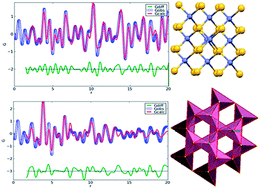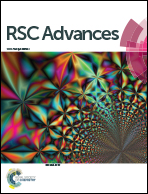A study of nanostructured ZnS polymorphs by synchrotron X-ray diffraction and atomic pair distribution function†
Abstract
The atomic structures of polymorphs of Zn–S nanocubes and nanowires have been studied using atomic pair distribution function (PDF) analysis and total synchrotron X-ray scattering data. The PDF of sample S1 shows face centered cubic packing and sample S2 shows a hexagonal closed packed structure. Phase transformations were observed with homogenous and nonhomogeneous treatment of temperature. Samples were synthesized by a hydrothermal method. PDF suggested a cation–cation (Zn2+–Zn2+) distance for S1 and S2 at 3.85 Å with coordination numbers ∼1 and ∼4, respectively. The core structure of a cubic ZnS nanostructure with extensive stacking faults was confirmed by TEM. The diameters of the samples were extracted using PDF data which are in good agreement with the TEM results. The FE-SEM and TEM results show that samples S1 and S2 have nanocube and nanowire-like structures, respectively. The interatomic distance was calculated by considering the PDF analysis. The energy band gap of the samples was estimated using UV-Vis spectra. It was observed that the energy band gap goes on decreasing during the structural transformation from cubic to wurtzite structure.


 Please wait while we load your content...
Please wait while we load your content...